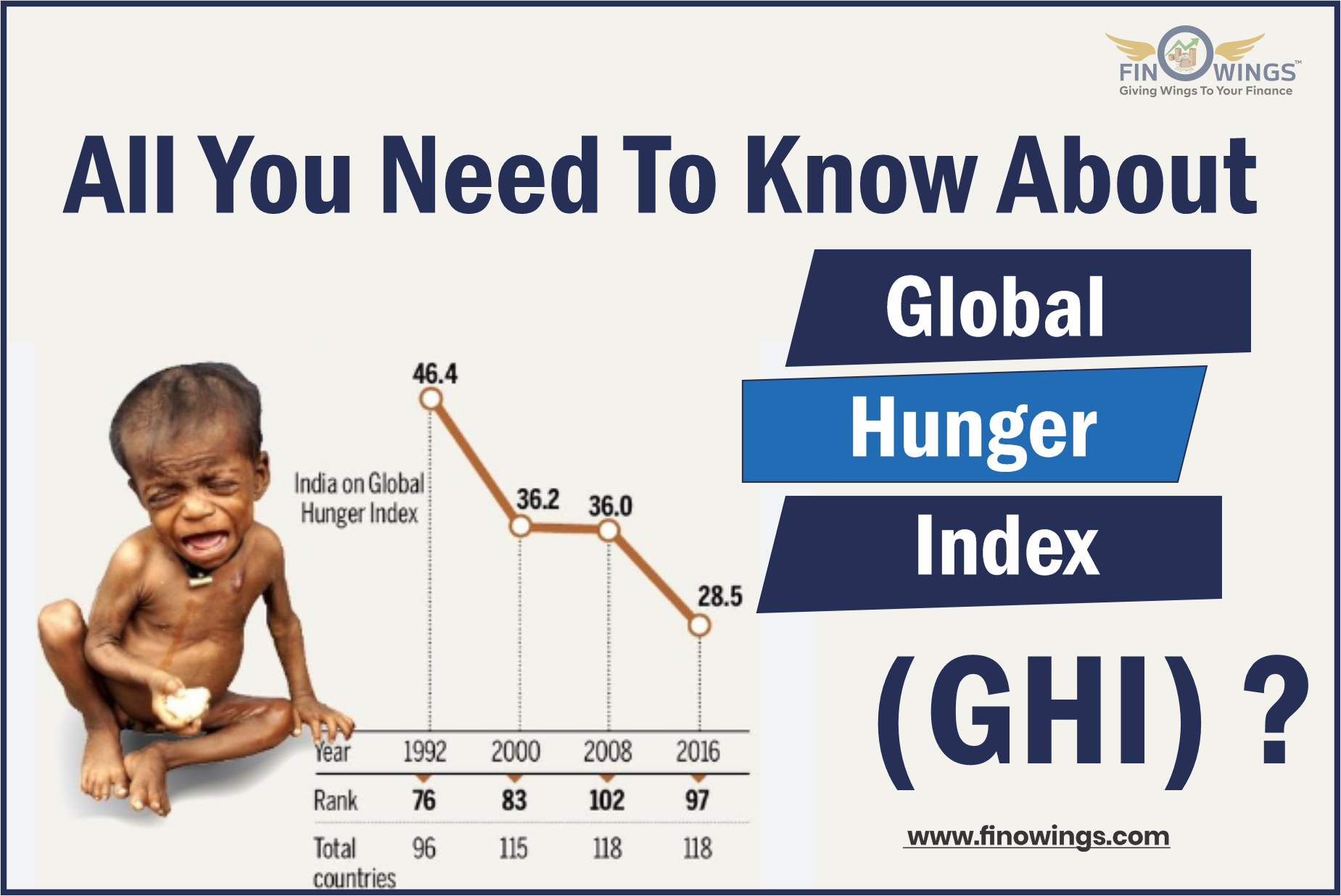Home >> Blog >> Global Hunger Index 2022: Harsh Reality of India's Hunger
Global Hunger Index 2022: Harsh Reality of India's Hunger

Table of Contents
The Global Hunger Index 2022 sees India 107th out of 121 nations, down from the 101st spot the year before.
The Global Hunger Index GHI, collaboratively released by Concern Worldwide and Welthungerhilfe, ranks nations according to their "severity." Yemen is ranked 121st, well down the list, dominated by European countries like Croatia, Estonia, and Montenegro. China and Kuwait have rated at the top among Asian countries.
1. What is the Global Hunger Index?
Since 2000, the GHI has been released virtually yearly; this year's analysis is the fifteenth. A lower score raises a nation's ranking and suggests improved results.
To accomplish "Zero Hunger by 2030," one of the Sustainable Development Objectives outlined by the United Nations, it is necessary to map hunger. This is why GHI rankings are not computed for some high-income nations.
From a technical perspective, hunger is quantified by mapping the amount of calorie intake, although, in common usage, it is defined in aspects of food deprivation.
However, the GHI does not confine itself to this specific interpretation of hunger. Instead, it monitors how well various nations operate on four important metrics because, when combined, they capture several aspects of hunger, including the lack of micronutrients, and so offer a much more thorough measurement of it.
2. How is hunger measured?
The GHI examines four key metrics:
-
Undernourishment (which shows poor food supply) (which reflects inadequate food availability): based on the percentage of the population that is undernourished (i.e., has inadequate calorie consumption);
-
Children's Waste (This is an indication of severe malnutrition): determined using the proportion of young children who are wasted (those who are underweight or overweight for their height);
-
Child Stunting (which shows chronic undernourishment): based on the proportion of children below the age of five that are stunted or underweight for their age;
-
Child Mortality (which is indicative of both harmful living conditions and poor nutrition.): estimated using the death rate for children under five, which is partially a result of the lethal combination of insufficient nutrition.
Each country's statistics are standardized on a scale of 100 points, and the final score is calculated by giving components 1 and 4 33.33% of the weight and 2 and 3 16.66%.
Countries with hunger scores of 9.9 or less are classified as "low"; those with scores of 20 to 34.9 are classified as "severe," and those with scores of over 50 are classified as "extremely concerning."
3. In comparison to the other countries, what is India's score?
India came in last with a hunger rating of 29.1, placing it in the "severe" classification behind its neighbors Nepal (81), Pakistan (99), Sri Lanka (64), and Bangladesh (84). Over time, India has seen a decline in GHI ratings. It received an "alarming" score of 38.8 in 2000, which fell to 28.2 by 2014. Since then, the nation has begun to post greater ratings.
India has normally reported lower numbers for the four metrics, but in 2014, the rates of undernutrition and child wasting began to increase. While the frequency of waste among children under five years of age increased from 15.1% in 2014 to 19.3% in 2022, undernourishment climbed from 14.8% in 2014 to 16.3% in 2022.
4. What are the results and consequences?
Among the world's biggest issues today is hunger, making it one of the greatest difficulties. Hunger and malnutrition create a vicious cycle frequently "transmitted" from one generation to the next. Children of poor parents frequently have low birth weights, worse immune systems, and experience situations that affect their mental development throughout their lives. Low income and poverty, war and violent conflict, the general absence of freedom, the low standing of women, and badly focused and implemented nutritional and health initiatives have all been recognized as contributing reasons to a high global hunger index 2022 list.
5. In which areas are the hunger problem the worst?
The Global Hunger Index for this year demonstrates the essential requirement for action in many nations to address the hunger problem.
Hunger is alarmingly high in five nations: Yemen, Madagascar, Chad, and the Democratic Republic of the Congo. A GHI score cannot be determined in several nations due to a lack of information. However, other nations - Burundi, Somalia, South Sudan, and Syria - have been tentatively classified as worrying based on other known evidence. This year's GHI results show that hunger rates are categorized as severe in 35 additional countries. Food insecurity still exists in some locations, even in nations and regions that receive high scores. Though, there are indications of improvement: 32 countries' GHI scores have decreased by 50% or more since 2000.
South Asia, where hunger is at its worst, and sub-Saharan Africa, where it is at its second worst, have alarming rates of hunger. South Asia has the greatest rates of child wasting and stunting of all the regions in the globe. The greatest child mortality rates and undernutrition are in Africa south of the Sahara. One of the worst droughts in the previous 40 years is affecting Ethiopia, Kenya, and Somalia in East Africa, endangering the lives of millions of people. Forecasts indicate that the globe won't be able to achieve the second UN Sustainable Development Goal (SDG 2), "Zero Hunger," by 2030 due to the climate issue.
6. What allegations are we looking at?
According to the Ministry for Women and Child Development, the study reduces India's ranking depending on calculations of the population's Proportion of the Undernourished (PoU). It explains that the American Food and Agriculture Organization's (FAO) assessment is dependent on the results of the Gallup World Poll's "Food Insecurity Experience Scale (FIES)" survey module, which included eight items and a response rate of 3,000 people.
According to the report, the data only made up a tiny part of a nation the size of India. In addition, it refuted claims made in the study that India's per capita dietary power supply was rising annually due to increased output of essential agricultural goods over time.
Significant explanations on these issues made by the government are offered on the global hunger index portal. According to this, the GHI only uses the PoU acquired through food balance sheets depending on the information identified by member countries, such as India. In contrast, the FAO uses a suite of indicators on food security, such as two significant indicators — the prevalence of undernourishment and the prevalence of moderate or severe food insecurity, depending on FIES. Moreover, a food balance sheet fully depicts a country's structure of food production over a certain time frame. In addition, it includes a list of the supply's origin and uses for each type of food.
According to the website, the GHI uses three of the four child-specific characteristics to estimate how hungry a nation's citizens are. The GHI ensures that both the effects of nutritional deficiencies within an especially vulnerable subset of the population are taken into account by incorporating the percentage of malnourished citizens (1/3 of the GHI rating) with the factors referring to children under the age of five (2/3 of the GHI rating), according to the statement.
All four measures used to calculate global hunger are recognized by the international community, including India, and are used to track progress toward the UN SDGs, according to Laura Reiner, a senior policy analyst at the GHI.
7. Why the controversy?
The Ministry claims that the paper is not only distant from actual events but also purposely ignores Central government measures to ensure food security, particularly during pandemics. In addition to their regular monthly quota of foodgrains as required by the National Food Security Act, the Union Cabinet provided an extra five kg of ration per person every month through the Pradhan Mantri Garib Kalyan Ann Yojna (PM-GKAY). Recently, it was continued to December 2022. In the opinion of Dipa Sinha, a professor of economics at Ambedkar University, the plans undoubtedly contributed to the situation's relief but were insufficient.
She asserts that people are not eating as they should be given unemployment, rising food costs, and stagnant salary levels. She went on to say that the pandemic-caused sorrow was simply a new layer that exacerbated an already bad situation. She informed, "We have several extra information resources that also confirm the notion that the problem of malnutrition and starvation in India is one of importance.
It is significant to highlight that the rating cannot be compared yearly because new countries with various economic situations are added for evaluation every year. Therefore, the economics professor argues that paying attention to the position and signal evaluation is more important than the relative rank year over year. The problem, according to her, is that the rank is low, not that it has increased or decreased.
The goal of the GHI, a yearly report that has undergone peer review, is to "completely quantify and track hunger at the global, regional, and country levels."
According to the Ministry for Women and Child Development, the study lowers India's ranking based on assessments of the population's Proportion of Undernourished (PoU).
The Ministry claims that the paper is not only distant from actual events but also purposely ignores Central government measures to ensure food security, particularly during pandemics.
Conclusion
A technique for thoroughly assessing and monitoring hunger at the international, regional, and national levels is the Global Hunger Index (GHI). The Global Hunger
Index indicators seek to monitor hunger on a global, regional, and national scale. The values of mainly four indicators are used to calculate GHI scores.

















